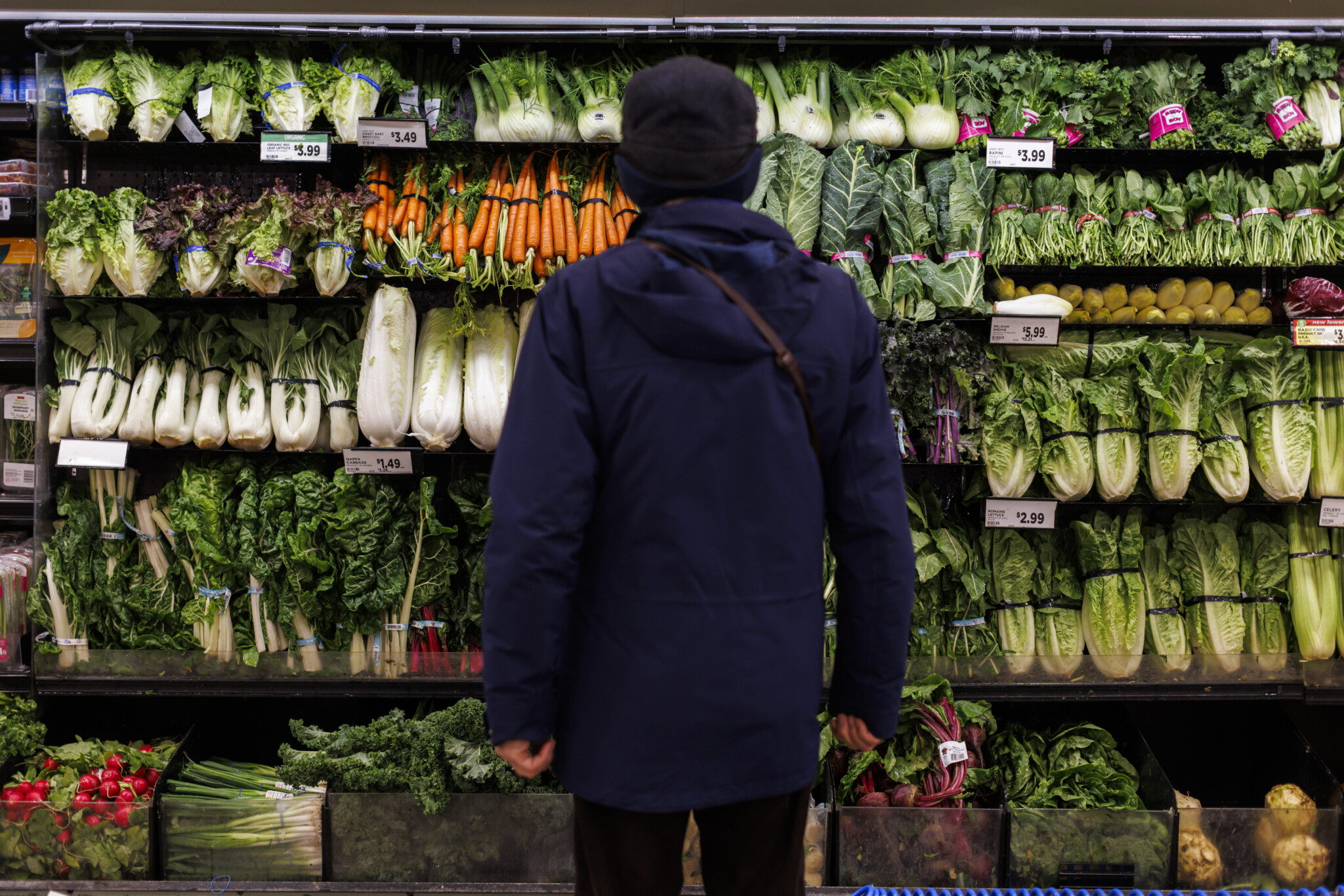In The Weekly Wrap Sean Speer, our editor-at-large, analyses for Hub subscribers the big stories shaping politics, policy, and the economy in the week that was.
Journalists should hold politicians to account, not be dependent on them
This week, The Hub was proud to sign the Ottawa Declaration on Canadian Journalism—a public declaration from a group of journalists and digital media outlets on the harms caused by the growing panoply of public subsidies for journalism.
We published only our third institutional editorial since 2021 to outline our rationale for signing and supporting the declaration. I won’t rehash its points here.
We’ve been pleased with the positive reaction to the declaration so far. Not only have we had some big-name journalists like Andrew Coyne and Paul Wells sign onto it, but, more importantly, it’s already started to catalyze a much-needed conversation about the magnitude of the public subsidies and their possible effects on the industry.
The scale of the subsidies isn’t well known. But it’s significant—in fact, there’s a good case that journalism is now among the most heavily subsidized sectors in the economy.
Eligible firms can receive a federal labour tax credit of 35 percent on per employee labour costs up to $85,000. In the Province of Quebec, print outlets can also claim a 35 percent tax credit on per employee wages up to $26,250. News outlets can also receive dedicated funding for journalists or freelance costs from the Local Journalism Initiative. And then of course there’s the government-mandated $100 million from Google for which we still don’t have the full details about its eventual distribution, including which firms will receive funding and how much.
The magnitude of public subsidies for Canadian journalism must be understood in cumulative terms. The stacking of subsidies (including direct and indirect) means that a significant share of newsroom costs for eligible firms are now defrayed by government support. We’ve previously estimated that as much as 50 percent of journalists’ salaries up to $85,000 could soon be covered by subsidies. In Quebec, the federal and provincial tax credits alone exceed 50 percent up to the eligible wage amounts.
There are of course other parts of Canada’s economy that benefit from government subsidies. There have been countless think-tank papers and opinion columns written over the years about the problem of “corporate welfare”, including notably in the auto and aerospace sectors. The recent case of massive subsidies for the electric vehicle industry is a good (or bad) example.
But in most of these instances, the government is subsidizing one-time capital expenditures. So while the absolute amount of public subsidies can be higher, it’s typically for a new plant or production line. There’s no other sector in the economy, to my knowledge, that’s receiving significant wage subsidies (as much as 50 cent dollars) to merely sustain its ongoing output.
If, as a news media company, the government is subsidizing in one form or another as much as half of your newsroom costs, are you actually a private company? And just as important, are you actually running a sustainable business?
For proponents of the subsidy regime, what’s the long-term plan? Do they envision subsidy-receiving firms to transition to market-based support over time? If so, how? Or are large-scale public subsidies for private news outlets the new natural order of things? And, if so, what’s the long term costs for the industry, including the public’s trust?
These are the types of questions we need to confront about the Trudeau government’s current media subsidy regime. We’re hopeful that the Ottawa Declaration can ultimately play a role in such a conversation.
Housing affordability seems like a magic trick on young Canadians
This week, Prime Minister Trudeau was criticized for refusing to say that housing prices will need to fall to restore affordability even if it comes at the expense of current homeowners.
His comments were broadly panned by housing policy observers and millennial spokespeople as representative of a fundamental problem with the housing file: no politician is seriously prepared to challenge the elevated asset values of those who are already in the market in order to help those who want to enter it.
This criticism is by and large fair. There’s been an unstated aspect to recent housing policy debates in which we can significantly increase housing supply (the government’s own goal is to effectively double annual housing construction) and improve affordability, without eroding the asset values of current homeowners.
The inherent tension isn’t limited to the prime minister’s own housing policy. It extends to every politician who is proposing policies to improve affordability. A key means of affordability is halting asset growth and even lowering it—especially since prices have risen in some markets by as much as 43 percent since 2019.
To the extent that the prime minister is worthy of being singled out compared to other politicians whose own policies involve the same contradiction, it may be due to the unseriousness of the government’s own projections for new homes over the coming years.
As Hub journalist Kiernan Green noted in an article this week, the Trudeau government’s target of 3.9 million new homes between now and 2031 would require that annual housing starts more than double relative to the norm over the past 20 years. Economist Hendrik Brankel summed it up this way in this week’s DeepDive: “There is simply no one in the housing industry who thinks that this is remotely achievable.”
It reflects a tendency towards magical thinking that has defined a lot of the Trudeau government’s policy agenda from housing, to electric vehicles, to deficit spending. In hindsight, the prime minister’s old line about how “the budget will balance itself” conveyed a wider insight about how he approaches complex policy issues.
But in his defence, the pile on around the prime minister’s housing comments wrongly dismisses the notion that rising incomes could do some of the work of closing the gap between incomes and housing prices. There’s an inherent fatalism to such commentary.
Income growth has been rather sluggish over the past several years. In fact, recent analysis by Hub contributor Trevor Tombe found that since 2015, real disposable incomes have increased in Canada by only 0.2 percent on average per year. One has to go back to the Great Depression or the early 1990s recession to find periods in which incomes grew slower for longer.
It’s wrong therefore to presume that faster-rising incomes cannot play any role in addressing the housing market’s income-price gap. Public policy should generally be oriented towards boosting incomes and living standards. One of the upsides can be to minimize the extent to which the housing affordability question is necessarily zero sum.
But faster-rising incomes are a necessary yet insufficient answer. If Canadian policymakers aren’t prepared to live with any reduction in housing values—even back to pre-pandemic levels—then young Canadians should view the promise of renewed affordability as nothing more than a magic trick.
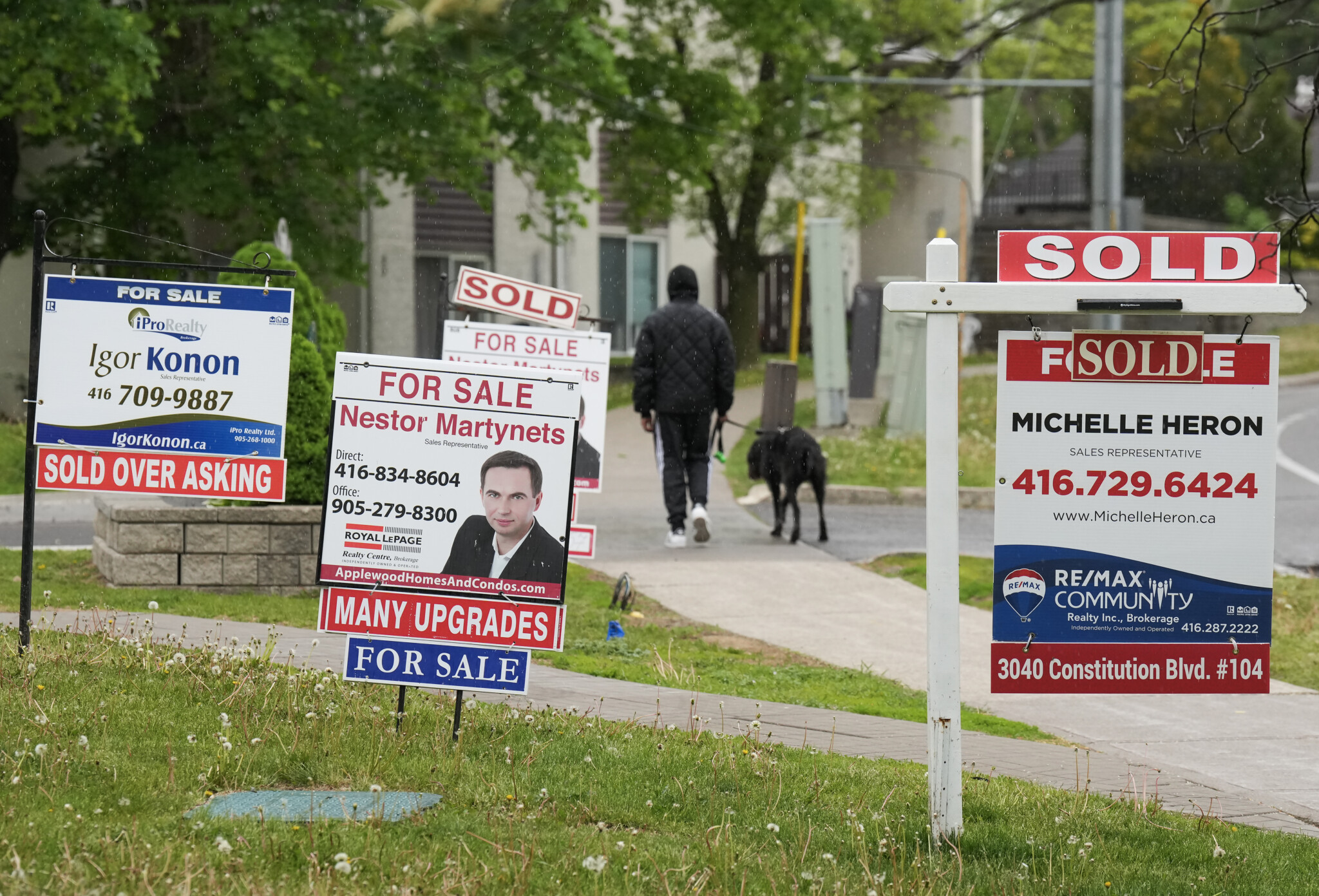
A person walks past multiple for-sale and sold real estate signs in Mississauga, Ont., on Wednesday, May 24, 2023. People renewing their mortgages or looking to buy a home are faced with a very different decision than they might have been just a few years ago, experts said, as rapid interest-rate increases have made fixed-rate mortgages with shorter terms more popular while variable-rate mortgage holders feel the pinch. Nathan Denette/The Canadian Press
Canada’s coming food price election
Political phenomena are rarely monocausal. They tend to represent a confluence of factors that work together in favour of a particular candidate, idea, policy, or sentiment.
While of course this is true, we should also resist the temptation to overcomplicate things. The search for nuance and complexity can sometimes cause us to miss simpler explanations.
Take the declining popularity of Prime Minister Trudeau and his government. One hears various explanations, including high-profile cases of government failure like its reckless immigration policy, the cumulative effects of the prime minister’s ethics scandals, the government’s propensity for divisive identity politics, etc.
Yet if one was looking for a single explanation—one data point—to help explain why, if an election were held today, the government would see its share of the vote sink to one of the lowest for an incumbent government in modern Canadian politics, he or she might find it in Trevor Tombe’s must-read analysis for The Hub from earlier this week.
He shows that while the inflation rate is indeed going down, price levels—particularly for salient goods such as food, rent and transportation—are now up by as much as 25 percent since 2020 and show few signs of falling any time soon.
Consider for instance that the largest year-over-year decline in “food purchasing power” in the post-war era is 2022 and the second largest is 2023. Tombe estimates that that food purchasing power is now about where it was in 2005 when Paul Martin was still prime minister.
The potential political consequences of such extraordinary price inflation are easy to understand. Canadians must confront their household budget pressures every time that they buy food. A trip to the grocery store creates the inverse (and rather destabilizing) reaction of the old Scotiabank slogan: “You’re richer than you think.”
The government can argue that the factors behind such elevated food prices are mostly beyond its control. But in a world in which household budgets are being tested by basic staples like food, it’s understandable that Canadians are anxious, angry, and inclined to punish incumbent governments.
It’s also an explanation for why the government has spent so much time talking about grocery chains and their pricing model. It instinctively understands that its biggest political threat isn’t the inflation rate itself. It’s the price of milk, meat, and other basic groceries.
Elections have been won and loss over the years on the basic question: “Are you better off than you were four years ago?”. One gets the sense that the next federal election, wherever it is held, may ultimately be decided on the question: “Is your grocery bill still higher than it was 20 years ago?”
Recommended for You

Laura David: Red pill, blue pill: Google has made its opening salvo in the AI-news war. What’s Canadian media’s next move?
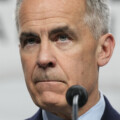
The Notebook by Theo Argitis: Mark Carney’s first major tests
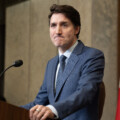
The Weekly Wrap: Trudeau left Canada in terrible fiscal shape—and now Carney’s on clean-up duty
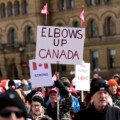
Ben Woodfinden: Lament for an ‘elbows up’ nation

